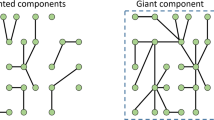Abstract
We present an analytically tractable model of Internet evolution at the level of Autonomous Systems (ASs). We call our model the multiclass preferential attachment (MPA) model. As its name suggests, it is based on preferential attachment. All of its parameters are measurable from available Internet topology data. Given the estimated values of these parameters, our analytic results predict a definitive set of statistics characterizing the AS topology structure. These statistics are not part of model formulation. The MPA model thus closes the “measure-model-validate-predict” loop, and provides further evidence that preferential attachment is the main driving force behind Internet evolution.
Access this chapter
Tax calculation will be finalised at checkout
Purchases are for personal use only
Preview
Unable to display preview. Download preview PDF.
Similar content being viewed by others
References
Faloutsos, M., Faloutsos, P., Faloutsos, C.: On power-law relationships of the Internet topology. In: SIGCOMM 1999: Proceedings of the conference on Applications, technologies, architectures, and protocols for computer communication, pp. 251–262. ACM Press, New York (1999)
Chang, H., Jamin, S., Willinger, W.: Internet connectivity at the AS-level: An optimization-driven modeling approach. In: MoMeTools 2003: Proceedings of the ACM SIGCOMM workshop on Models, methods and tools for reproducible network research, pp. 33–46. ACM Press, New York (2003)
Zhou, S., Mondragón, R.J.: Accurately modeling the Internet topology. Phys. Rev. E. 70, 066108 (2004)
Serrano, M.Á., Boguñá, M., Díaz-Guilera, A.: Competition and adaptation in an Internet evolution model. Phys. Rev. Lett. 94, 38701 (2005)
Serrano, M.Á., Boguñá, M., Díaz-Guilera, A.: Modeling the Internet. Eur. Phys. J. B 50, 249–254 (2006)
Chang, H., Jamin, S., Willinger, W.: To peer or not to peer: Modeling the evolution of the Internet’s AS-level topology. In: INFOCOM 2006. 25th IEEE International Conference on Computer Communications, Barcelona, Catalunya, Spain, April 23-29, 2006. IEEE, Los Alamitos (2006)
Wang, X., Loguinov, D.: Wealth-based evolution model for the Internet AS-level topology. In: INFOCOM 2006. 25th IEEE International Conference on Computer Communications, Barcelona, Catalunya, Spain, April 23-29, 2006. IEEE, Los Alamitos (2006)
D’Souza, R., Borgs, C., Chayes, J., Berger, N., Kleinberg, R.: Emergence of tempered preferential attachment from optimization. Proc. Natl. Acad. Sci. USA 104, 6112–6117 (2007)
Corbo, J., Jain, S., Mitzenmacher, M., Parkes, D.: An economically-principled generative model of AS graph connectivity. In: NetEcon+IBC 2007: Proceedings of the ACM Joint Workshop on The Economics of Networked Systems and Incentive-Based Computing. ACM Press, New York (2007)
Bar, S., Gonen, M., Wool, A.: A geographic directed preferential Internet topology model. Comput. Netw. 51(14), 4174–4188 (2007)
Holme, P., Karlin, J., Forrest, S.: An integrated model of traffic, geography and economy in the Internet. Comput. Commun. Rev. 38(3) (2008)
Krioukov, D., Chung, F., claffy, k., Fomenkov, M., Vespignani, A., Willinger, W.: The workshop on Internet topology (WIT) report. Comput. Commun. Rev. 37(1) (2007)
Mahadevan, P., Krioukov, D., Fall, K., Vahdat, A.: Systematic topology analysis and generation using degree correlations. In: SIGCOMM 2006: Proceedings of the 2006 conference on Applications, technologies, architectures, and protocols for computer communications, pp. 135–146. ACM Press, New York (2006)
Dimitropoulos, X., Krioukov, D., Riley, G., Vahdat, A.: Graph annotations in modeling complex network topologies. ACM Transactions on Modeling and Computer Simulation (to appear, 2009) arXiv:0708.3879
Barabási, A.-L., Albert, R.: Emergence of scaling in random networks. Science 286, 509–512 (1999)
Dorogovtsev, S.N., Mendes, J.F.F., Samukhin, A.N.: Structure of growing networks with preferential linking. Phys. Rev. Lett. 85(21), 4633–4636 (2000)
Krapivsky, P.L., Redner, S., Leyvraz, F.: Connectivity of growing random networks. Phys. Rev. Lett. 85(21), 4629–4632 (2000)
Dimitropoulos, X., Krioukov, D., Riley, G., claffy, k.: Revealing the Autonomous System taxonomy: The machine learning approach. In: PAM 2007: Proceedings of the 7th International Conference on Passive and Active Network Measurement, Adelaide, Australia, March 30-31 (2006)
Chang, H., Govindan, R., Jamin, S., Shenker, S.J., Willinger, W.: Towards capturing representative AS-level Internet topologies. Comput. Netw. 44(6), 737–755 (2004)
Mahadevan, P., Krioukov, D., Fomenkov, M., Huffaker, B., Dimitropoulos, X., claffy, k., Vahdat, A.: The Internet AS-level topology: Three data sources and one definitive metric. Comput. Commun. Rev. 36(1), 17–26 (2006)
University of Oregon RouteViews Project, http://www.routeviews.org/
Dimitropoulos, X., Krioukov, D., Fomenkov, M., Huffaker, B., Hyun, Y., claffy, k., Riley, G.: AS relationships: Inference and validation. Comput. Commun. Rev. 37(1) (2007)
Zhou, S., Zhang, G., Zhang, G.: The Chinese Internet AS-level topology. IET Commun. 1(2), 209–214 (2007)
CAIDA. AS Relationships Data. Research Project, http://www.caida.org/data/active/as-relationships/
Albert, R., Barabási, A.-L.: Statistical mechanics of complex networks. Rev. Mod. Phys. 74, 47–97 (2002)
Dorogovtsev, S.N., Mendes, J.F.F.: Evolution of Networks: From Biological Nets to the Internet and WWW. Oxford University Press, Oxford (2003)
Newman, M.E.J.: The structure and function of complex networks. SIAM Rev. 45(2), 167–256 (2003)
Boccaletti, S., Latora, V., Moreno, Y., Chavez, M., Hwanga, D.-U.: Complex networks: Structure and dynamics. Phys. Rep. 424, 175–308 (2006)
Author information
Authors and Affiliations
Editor information
Editors and Affiliations
Rights and permissions
Copyright information
© 2009 ICST Institute for Computer Science, Social Informatics and Telecommunications Engineering
About this paper
Cite this paper
Shakkottai, S., Fomenkov, M., Koga, R., Krioukov, D., Claffy, K. (2009). Evolution of the Internet AS-Level Ecosystem. In: Zhou, J. (eds) Complex Sciences. Complex 2009. Lecture Notes of the Institute for Computer Sciences, Social Informatics and Telecommunications Engineering, vol 5. Springer, Berlin, Heidelberg. https://doi.org/10.1007/978-3-642-02469-6_40
Download citation
DOI: https://doi.org/10.1007/978-3-642-02469-6_40
Publisher Name: Springer, Berlin, Heidelberg
Print ISBN: 978-3-642-02468-9
Online ISBN: 978-3-642-02469-6
eBook Packages: Computer ScienceComputer Science (R0)




